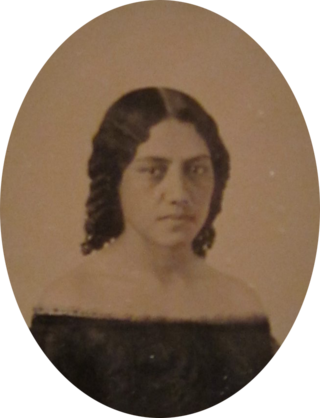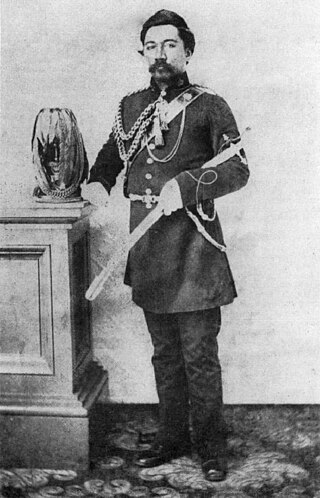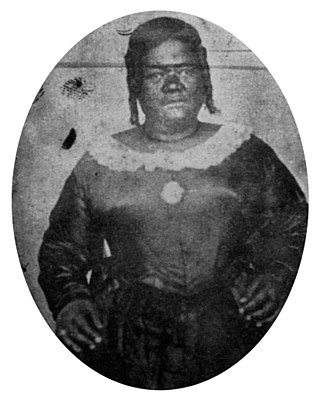
Bernice Pauahi Pākī Bishop KGCOK RoK was an aliʻi (noble) of the royal family of the Kingdom of Hawaii and a well known philanthropist. At her death, her estate was the largest private landownership in the Hawaiian Islands, comprising approximately 9% of Hawaii's total area. The revenues from these lands are used to operate the Kamehameha Schools, which were established in 1887 according to Pauahi's will. Pauahi was married to businessman and philanthropist Charles Reed Bishop.

Lunalilo was the sixth monarch of the Kingdom of Hawaii from his election on January 8, 1873, until his death a year later.

Kamehameha V, reigned as the fifth monarch of the Kingdom of Hawaiʻi from 1863 to 1872. His motto was "Onipaʻa": immovable, firm, steadfast or determined; he worked diligently for his people and kingdom and was described as the last great traditional chief.

Victoria Kamāmalu Kaʻahumanu IV was Kuhina Nui of Hawaii and its crown princess. Named Wikolia Kamehamalu Keawenui Kaʻahumanu-a-Kekūanaōʻa and also named Kalehelani Kiheahealani, she was mainly referred to as Victoria Kamāmalu or Kaʻahumanu IV, when addressing her as the Kuhina Nui. In her role of Kuhina Nui, she acted as Regent between the death of the King in 1863 until the election of a new King the same year.

Princess Kalani Ahumanu i Kaliko o Iwi Kauhipua o Kīnaʻu, also known as Elizabeth Kīnaʻu was Kuhina Nui of the Kingdom of Hawaiʻi as Kaʻahumanu II, queen regent and dowager queen.

Elizabeth Kekaʻaniau Laʻanui Pratt, full name Elizabeth Kekaʻaniauokalani Kalaninuiohilaukapu Kekaikuihala Laʻanui Pratt, was a Hawaiian high chiefess (aliʻi) and great-grandniece of Kamehameha I, being a great-granddaughter of Kalokuokamaile, the older brother of Kamehameha I, founder of the Kingdom of Hawaii. She was the daughter of Gideon Peleʻioholani Laʻanui and Theresa Owana Kaheiheimalie Rives.

Moses Kekūāiwa was a member of the royal family of the Kingdom of Hawaii.

Kalākua Kaheiheimālie, later known as Hoapili Wahine was a member of Hawaiian royalty who was one of the queen consorts at the founding of the Kingdom of Hawaii. She was the mother of another queen consort, and grandmother of two future kings. Some sources call her Kaheiheimaile rather than Kaheiheimālie. "Mālie" means serene while the "maile" is the vine Alyxia olivaeformis. The second spelling seems to be older and more appropriate.

Peter Young Kaʻeo Kekuaokalani was a Hawaiian high chief (aliʻi) and politician of the Kingdom of Hawaii. His cousin was Emma, who contended for the throne after the death of Kamehameha. After being diagnosed with leprosy, he was exiled in 1873 to Kalaupapa, the isolation settlement on Molokaʻ. He was later permitted to return to Honolulu, where he died.
Jane Loeau was a Hawaiian chiefess during the Kingdom of Hawaii who attended the Chiefs' Children's School, also known as the Royal School.
Abigail Maheha was a Hawaiian chiefess (aliʻi) of the Kingdom of Hawaii. At a young age, she was chosen to attend the Chiefs' Children's School taught by the American missionary Amos Starr Cooke and his wife, Juliette Montague Cooke, alongside her half-sister Jane Loeau and fourteen of her royal cousins.

Kaʻiminaʻauao was a Hawaiian high chiefess who was given in adoption to Queen Kalama and King Kamehameha III. She died of the measles at the age of three, during an epidemic of measles, whooping cough and influenza that killed more than 10,000 Native Hawaiians. Her elder brother and sister became King Kalākaua, and Queen Liliʻuokalani.
James Kaliokalani, also referred to as Kali; was a Hawaiian high chief of the Kingdom of Hawaii. At a young age, he was chosen to attend the Chiefs' Children's School. He was taught by the American missionary Amos Starr Cooke and his wife, Juliette Montague Cooke, alongside his siblings and thirteen of their royal cousins, who were declared eligible to succeed to the Hawaiian throne. He died in 1852, shortly after leaving the school and working as a court interpreter.

Keahikuni Kekauʻōnohi was a Hawaiian high chiefess who was a member of the House of Kamehameha. She was granddaughter to King Kamehameha I and one of the wives of Kamehameha II. Her Christian name is disputed; it is given as Mikahela in the 1848 Mahele Book and as Miriam in later sources.

John William Pitt Kīnaʻu was a prince of the Kingdom of Hawaii and the only surviving son of High Chief William Pitt Leleiohoku I and Ruth Keʻelikōlani. As a descendant of King Kamehameha I, he was chosen to attend the Chiefs' Children's School taught by the American missionary Amos Starr Cooke and his wife, Juliette Montague Cooke, alongside fifteen of his royal cousins. At a young age, he inherited the landholdings of his father and his adoptive grandfather including Huliheʻe Palace, but the prince died under mysterious circumstances before his seventeenth birthday.
Mary Polly Paʻaʻāina, also known as Mary ʻĪʻī was a Hawaiian chiefess of the Kingdom of Hawaii. At a young age, she was chosen to attend the Chiefs' Children's School taught by the American missionary Amos Starr Cooke and his wife, Juliette Montague Cooke, alongside her half-sister Queen Emma of Hawaii and fourteen of her royal cousins.
ʻAikanaka was a high chief of the Kingdom of Hawaii and grandfather of two of Hawaii's future monarchs.

Mary Ann Kiliwehi Kaʻauwai was a Hawaiian high chiefess and lady-in-waiting of the Kingdom of Hawaii. Alongside her husband William Hoapili Kaʻauwai, she traveled with Queen Emma of Hawaii to Europe between 1865 and 1866, and circumnavigated the globe upon their return eastward via New Zealand.
Keanolani was a Hawaiian chiefess (aliʻi) of the Kingdom of Hawaii. She was the illegitimate daughter of Abigail Maheha and King Kamehameha V, who reigned from 1863 to 1872, and was born during a liaison between the two when they were students at the Chiefs' Children's School, a boarding school run by American missionaries for students of Hawaiian royal descent. Keanolani was raised by her father's half-sister Keʻelikōlani. Her illegitimate birth and unacknowledged parentage prevented her from succeeding to the Hawaiian throne when her father died without naming an heir, thus ending the reign of the House of Kamehameha. In 1873, she became a mistress of her uncle by marriage William Hoapili Kaʻauwai. In 1874, she became a supporter of the newly elected House of Kalākaua. She married and left descendants. Her name is also often spelled as Keano or Keanu. In one source, she is named as Keauoʻokalau.

Juliette Montague Cooke, known as "Mother Cooke", was an American teacher, a member of the Eighth Company of missionaries sent by the American Board of Commissioners for Foreign Missions (ABCFM) to the Hawaiian Islands.

















